Jonathan Pinnock's Blog, page 5
July 1, 2019
What I Read in June
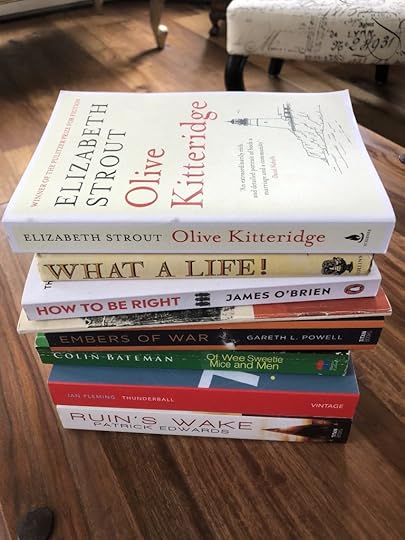
I’ve been getting lazy about reading lately, what with one thing and another. Up until the year before last, I was regularly reading at least 70 or 80 (sometimes even 90) books a year. But last year it dropped, for no good reason, and the start of this year has also been pretty dismal (although there has been at least one good reason for that). So I’ve decided to make a concerted effort to start reading properly again. For one thing, I really can’t pretend to be a writer myself if I don’t read much. More importantly, it’s good for you. I genuinely feel better when I read regularly.
The other thing I’ve got lazy about is reviewing books. I did set up a YouTube channel last year, but I didn’t manage to keep that going for very long – although perhaps I’ll give it another go one day. I also get very anxious about choosing a star rating on places like Amazon and GoodReads and I tend to go into chronic overthinking mode.
So this is what I’m going to do from now on. At the start of each month I’m going to post a picture of what I’ve read in the preceding month, with a sentence or two (nothing more) on each. Let’s hope that doesn’t prove too ambitious.
Anyway, this month I read eight books:
Ruin’s Wake by Patrick Edwards – I was fortunate to be on the same critique group on my MA course as Paddy, so I had a ringside seat as this debut novel of his emerged into life. It’s possible that I’m biased, but I think it’s magnificent: an epic tale, full of believable characters, great themes, some terrific world-building and some really interesting ideas.
Thunderball by Ian Fleming – A few years back I began a sporadic project to read all of the James Bond novels. I’m not entirely sure why, but now I’ve started, I’m damned well going to finish. I have to say that the first few aren’t – in my opinion – terribly well written. But by the time we get to Thunderball (number nine in the series), things have got somewhat better – provided, that is, you’re prepared to turn a blind eye to the casual sexism and racism – and this was an entertaining read.
Of Wee Sweetie Mice and Men by Colin Bateman – This is the follow-up to the splendid Divorcing Jack, which I read back in 2017. Not quite as good as the first one, but still quite a fun read. My only criticism is the same one as I had of Divorcing Jack, in that some of the things that happen to people in it, both good and bad, don’t feel truly earned. I wonder if it derives from Bateman’s background as a journalist during the Troubles. Or maybe I’m just being over-moral.
Embers of War by Gareth Powell – Epic bit of space opera, first part of a trilogy. This doesn’t have a dominant central character like Ack-Ack Macaque (although Trouble Dog, the sentient retired battleship, is nicely odd), but nonetheless it’s an absorbing read. I’ll be ordering the next book in the series, Fleet of Knives, soon.
Nothing to Worry About by Vanessa Gebbie – The queen of flash on top form here. By turns bizarre, funny and profound. Everything flash fiction ought to be, and yet so often falls short.
How to be Right by James O’Brien – Entertaining lightning guided tour of the issues of the day, from Brexit to Trump, conducted by everyone’s favourite liberal shock jock. Also, a crash course in dialectic for klutzes like me who are brilliant at thinking up the perfect comeback – three days too late.
Olive Kitteridge by Elizabeth Strout – Oh, where has Elizabeth Strout been all my life? Come to that, where has Olive Kitteridge been? Wonderful, wonderful book, and straight into my top ten favourites. Top ten? Top three!
What a Life! by EV Lucas and George Morrow – Bizarre exercise in early 20th century surrealism. Get it at Abebooks for a quid or so and have one of the most enjoyable hours of your life. I laughed out loud several times.
Feel free to chip in the comments if you disagree or even if you agree.
The post What I Read in June appeared first on Jonathan Pinnock - Writer of Stuff.
June 10, 2019
Quotes and Stuff
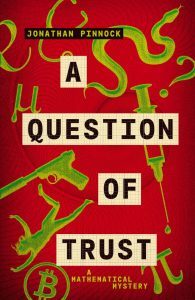
I’m not sure I’ll ever really get over what a weird roller-coaster ride having a book published is. You and your publishers do your damnedest to make it the best thing you possibly can, but once it’s out in the world, no-one really has any idea what’s going to happen. It’s wise to remember the military adage that no plan survives contact with the enemy.
But when the book goes up on NetGalley a few weeks before publication, you still have a certain level of expectation. After all, before THE TRUTH ABOUT ARCHIE AND PYE came out, there was a decent flurry of activity, resulting in a respectable number of reviews on GoodReads and Amazon when it was actually released. This time, with A QUESTION OF TRUST, not so much. No idea why, because the reviews that are posted are almost all very positive. So you begin to wonder if anyone is ever going to read this book you’ve slaved over – especially as the Amazon rankings (not that I spend much time looking at them, oh no) show the first book seemingly outselling the second one most of the time.
And then, out of the blue, something rather wonderful happens. Someone at Farrago had the brilliant idea of sending a copy to Professor Ian Stewart, the chap who wrote the excellent Science of Discworld books, amongst many other things. This morning he emailed them back to say:
Brilliant book! I’ll now buy Archie and Pye…
A dash of IT, a sprinkle of maths, an engaging and all-too-believable cast of anti-heroes, and a bonkers plot with all the precision and elegance of a Fibonacci spiral. Profane, irreverent, witty, well-aimed, and fizzing with imagination.
Perfect. I have to say I am MASSIVELY chuffed. This is a man who worked with one of my literary heroes, after all. I couldn’t have asked for anything better.
I’d better get back to work on Book 3, then, hadn’t I?
I have also been featured in a cryptocurrency blog, which is something of a first for me. This is what David Gerard, the prominent Bitcoin-sceptic, said:
The scene where the main character’s father talks about the ICO he just bought into is chillingly true to life.
The funny thing about that is that the scene in question came entirely from my imagination, so I’m especially pleased about this.
Finally, here’s a guest post I wrote for the Retreat West blog, in which I discuss the differences between writing a stand-alone book and writing a series. Many thanks to Amanda Saint for letting me drop in.
The post Quotes and Stuff appeared first on Jonathan Pinnock - Writer of Stuff.
May 15, 2019
Right. Where was I?
 Well, apologies for that unscheduled break in transmission. There are Reasons, which I’m not going to bore you with quite yet – although it’s quite possible that I will choose to bore you with them at some point in the future. However, in the immortal words of Take That, I am now Back For Good.
Well, apologies for that unscheduled break in transmission. There are Reasons, which I’m not going to bore you with quite yet – although it’s quite possible that I will choose to bore you with them at some point in the future. However, in the immortal words of Take That, I am now Back For Good.
Quite apart from all this, if you happened to drop in on this place during the last few weeks, you may have noticed some odd behaviour, such as this entire blog disappearing, followed a few days later by the entire site. This was caused by a hacker who somehow managed to get access to my cPanel (despite my having upgraded the password prior to this). I’m not entirely sure what his game was, because rather weirdly he changed the contact details for the site to his own, so I actually know his name and address. I’ve half a mind to pass them on to the authorities in Tamil Nadu, although I’m not sure they’d bother with anyone quite that inept. The important thing is that my hosting company, Host4U, were absolutely BRILLIANT and managed to restore everything from backups when I was convinced that I’d lost the whole lot. I can’t recommend them enough.
Now that the site’s back in full working order, I’ve tarted it up a bit, mainly to incorporate my new book A QUESTION OF TRUST, which was inconveniently published during the aforementioned break in transmission. Here are the highlights:
The Mathematical Mystery series now has its own dedicated mini site.
A QUESTION OF TRUST now has its own micro site within the MM series.
Signed copies of A QUESTION OF TRUST are now available at the Shop.
Incidentally, if you’re on NetGalley, you can still get to read A QUESTION OF TRUST for free. It’s got some nice reviews so far, but it could do with a few more. It’s a sequel to THE TRUTH ABOUT ARCHIE AND PYE, although you don’t have to have read that first to enjoy it.
And finally, I was very pleased to read that MRS DARCY VERSUS THE ALIENS (remember that?) was recently listed as one of Electric Lit magazine’s favourite Pride and Prejudice variations, alongside such immortal classics as “Pride and Platypus”, which sounds awesome.
The post Right. Where was I? appeared first on Jonathan Pinnock - Writer of Stuff.
April 10, 2019
Hello world!
Welcome to WordPress. This is your first post. Edit or delete it, then start writing!
February 26, 2019
Sequels Galore!

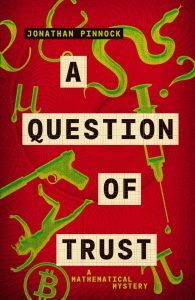 As I’ve already mentioned, A QUESTION OF TRUST, Book Two in the Mathematical Mystery series, is coming out in April. Obviously I’m excited about this, because the thrill of getting a book published never wears off. But I’m particularly excited because, as the second book in a series, it gets a cover that matches the other book in the series (and don’t they look good together?).
As I’ve already mentioned, A QUESTION OF TRUST, Book Two in the Mathematical Mystery series, is coming out in April. Obviously I’m excited about this, because the thrill of getting a book published never wears off. But I’m particularly excited because, as the second book in a series, it gets a cover that matches the other book in the series (and don’t they look good together?).
But there’s more. I’ve just signed a new contract with Farrago to write two more Mathematical Mysteries, which means there are very soon going to be four of the buggers, all with matching covers. I almost feel like a proper author now.
I’m still kicking around the precise details of the plot, but I think I can safely reveal that the book is almost certainly going to be called THE CURSE OF THE VAVASORS. I can also safely say that you’re going to like it.
Now, for those of you who are currently touting your work around agencies and independent publishers and getting rebuffed at every turn, I’d like to offer you a few crumbs of comfort. I don’t think I’ve shared these with you before (at least not here), but here are the stats on Archie and Pye.
In total, I submitted THE TRUTH ABOUT ARCHIE AND PYE to 42 agents and 10 independents. Of the agents, 15 didn’t bother responding at all, another 12 gave a form rejection, 9 gave a nice, personalised rejection and 5 asked to see the full manuscript, before saying no, and one responded too late after I’d already signed with Farrago. Of the independents, 6 didn’t bother responding, one gave a form rejection and 2 gave nice, personalised rejections.
And then Farrago said yes.
(I still haven’t got an agent, by the way, but for the time being I’m cool with that.)
So I think what I’m basically saying is this:
The post Sequels Galore! appeared first on Jonathan Pinnock - Writer of Stuff.
February 11, 2019
A Question of Trust Gets a Cover
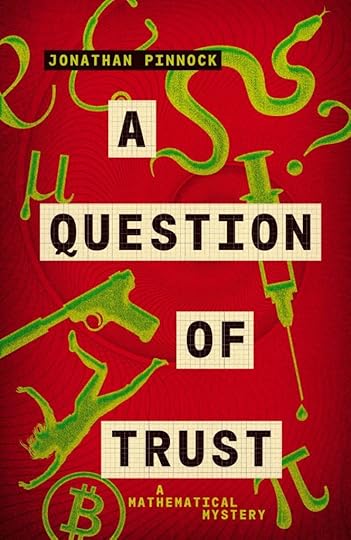 The problem with having goals is that they’re constantly changing. When you start off as a writer, your first target tends to be something like “get a short story published somewhere”, and then once that’s out of the way, you move on to “get a short story published somewhere nice.”
The problem with having goals is that they’re constantly changing. When you start off as a writer, your first target tends to be something like “get a short story published somewhere”, and then once that’s out of the way, you move on to “get a short story published somewhere nice.”
And when that’s ticked off the list, you begin to wonder about getting a novel published. Now getting a novel published is always exciting, because there is a considerable amount of work involved. However, there’s always a little voice in the back of your head that’s saying something like “y’know, what I’d really like is a series of novels with matching covers.”
Well, here we are.
So may I present to you the amazing cover for A QUESTION OF TRUST, the second book in the Mathematical Mystery series? Once again, it’s the work of the brilliant Mark Swan aka kid-ethic, and once again it’s absolutely perfect.
The book is out on April 18th and it should be available for pre-order soon, too, but just to whet your appetite, here’s the blurb:
Life is not going smoothly for Tom Winscombe.
His girlfriend Dorothy has vanished, taking with her all the equipment and money of the company she ran with her friend Ali. Now Tom and Ali are forced to eke out an awkward shared bedsit existence while they try to work out what she is up to.
Meanwhile, Tom has other things on his mind, including how to untangle his father from a cryptocurrency scam, how to break into a hospital in order to interrogate an old acquaintance and what is the significance of the messages he’s been receiving from Rufus Fairbanks’s LinkedIn account.
Tom and Ali’s investigations lead them in a host of unexpected and frankly dangerous directions, involving a pet python, an offshore stag do and an improbable application of the Fibonacci sequence. But at the end of it all, will they find Dorothy – and will she ever be able to explain just exactly what is going on?
Well, I’m certainly excited!
The post A Question of Trust Gets a Cover appeared first on Jonathan Pinnock - Writer of Stuff.
January 12, 2019
Schrödinger’s Book
 Shortly before the Christmas break, I delivered the manuscript of A QUESTION OF TRUST, otherwise known as Book Two in the Mathematical Mysteries Series, to my editor at Farrago. Put like that, it doesn’t sound terribly scary. However, what you need to know is that the seventy-odd thousand words in that manuscript hadn’t previously been seen by anyone else at all, primarily because of my inept deadline management as described in the previous post to this one.
Shortly before the Christmas break, I delivered the manuscript of A QUESTION OF TRUST, otherwise known as Book Two in the Mathematical Mysteries Series, to my editor at Farrago. Put like that, it doesn’t sound terribly scary. However, what you need to know is that the seventy-odd thousand words in that manuscript hadn’t previously been seen by anyone else at all, primarily because of my inept deadline management as described in the previous post to this one.
So it was entirely possible that any number of things could have gone horribly wrong with what I’d delivered. The jokes could have fallen flat. The character developments I’d envisaged could have been completely wrong. In fact, the entire plot could have been absolutely terrible.
Which is why I very much felt that at the time I delivered it, A QUESTION OF TRUST was Schrödinger’s book (that’s him, there, BTW
Thankfully, Abbie at Farrago hinted before Christmas that she was enjoying what she’d read so far – which, for all I knew, could have just been the title page, but it was enough to get me through the festive season without being too unpleasant to my family. The final verdict arrived this week and fortunately it turned out that the book was not entirely without merit, so we are good to go with the edits. Scary business, though. In many ways, it’s far easier to come up with something out of the blue than to produce a follow-up, because there’s no expectation. I just hope that the readers out there will feel the same way about this one as they did about THE TRUTH ABOUT ARCHIE AND PYE. I think they will, but then I would, wouldn’t I?
Speaking of ARCHIE AND PYE…
Considering what I’m usually like, I haven’t made a lot of fuss here about the splendid reviews that it’s had over the last few months. This isn’t for reasons of modesty (because, obviously, I’m not like that), but more because of having spent most of the time scribbling frantically away at Book Two (see above).
Anyway, if you fancy having a quick gander at them, most of them are on Goodreads and those that aren’t are on either Amazon UK or Amazon US. Don’t believe any writer who claims not to read their reviews, by the way. They are lying. Or at the very least more disciplined than I am, anyway.
I was particularly chuffed to see ARCHIE AND PYE turn up in a few best-of-2018 lists at the end of the year. Here’s Scott Pack, for one:
10. JONATHAN PINNOCK – THE TRUTH ABOUT ARCHIE & PYE
This mathematical thriller is very silly but equally clever. Shades of Douglas Adams. If you want to immerse yourself into a book that is fun from start to finish then you won't go far wrong with this. pic.twitter.com/cTHgNDO8Fl
— Scott Pack (@meandmybigmouth) December 15, 2018
And here’s Bloomin’ Brilliant Books:
I also want to give a shout out to a book that I have read in a different capacity and, therefore, not reviewed but which I have a huge soft spot for. That book is The Truth About Archie and Pye by Jonathan Pinnock. It is hilarious, and I urge you to read it.
Finally, here’s Our Book Reviews Online:
The Truth about Archie and Pye: a mathematical mystery by Jonathan Pinnock (Farrago) – an off-beat, quirky thriller. After a chance encounter on a train, Tom Winscombe finds himself in possession of a case full of mathematical equations that everyone (including the Belorussian mafia) seems to want, and they’re not afraid to kill anyone standing in the way. It’s fast-paced, funny, and you don’t need to know anything about maths to enjoy it.
The post Schrödinger’s Book appeared first on Jonathan Pinnock - Writer of Stuff.
December 31, 2018
So Farewell Then, 2018
Well, that was an interesting year, no question about it. I began 2018 fully expecting the sole highlight to be the publication of my second book of short stories, DIP FLASH. However, all that changed in February when, following a whirlwind exchange of manuscript and contract, I signed a deal with Farrago for the publication of my second novel, THE TRUTH ABOUT ARCHIE AND PYE, and its as then unnamed successor. I’m beginning to think that book deals are like buses. You hang around for ages waiting for one to show up, and then you get two in rapid succession – see also MRS DARCY VERSUS THE ALIENS and DOT DASH.
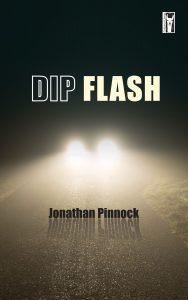 DIP FLASH was duly published by Cultured Llama at the end of March and, despite bearing blurbs from living legends Joanne Harris and David Gaffney, it received about as much attention as collections of short stories from small publishers usually do. I would probably have found this upsetting if it weren’t for the fact that I knew that I had something else to look forward to later on in the year. However, it’s there and I know it’s got some good stuff in it, even if hardly anyone else does. Signed copies available here, by the way.
DIP FLASH was duly published by Cultured Llama at the end of March and, despite bearing blurbs from living legends Joanne Harris and David Gaffney, it received about as much attention as collections of short stories from small publishers usually do. I would probably have found this upsetting if it weren’t for the fact that I knew that I had something else to look forward to later on in the year. However, it’s there and I know it’s got some good stuff in it, even if hardly anyone else does. Signed copies available here, by the way.
Given that as of February, I was now committed to writing a new novel by the end of October (which slipped a little in the end, but not TOO much), I made a rapid decision that short stories were off the agenda for at least a year. I wonder if this contributed a little to me not promoting DIP FLASH as much as perhaps I should – it’s hard to go around touting a book of short stories if you’re not actually writing any at the moment. As it happened, it was disturbingly easy to put stories to one side for a year, although having sent in the manuscript for the next novel, I have had the occasional twinge. We’ll see.
The edit notes on ARCHIE AND PYE came through at the start of March and I spent the next couple of months working on them, the most pressing issue being the reduction in the word count from 90000 to 75000. Helpfully, Abbie Headon, my editor, had somehow managed to identify every single part of the text that I’d secretly known had to go but hadn’t admitted yet. But it was still a tough time, especially as I was fully aware that every day I spent on the edits of Book One was a day that I wasn’t writing Book Two (which at that time still had a deadline of the end of October).
May and June brought the copyedits, all of which went through remarkably smoothly, and then everything went quiet for a while, enabling me to get on with Book Two. Actually, this isn’t entirely accurate, because an unexpected day job spike popped up in May, which meant that all my plans got shifted sideways once more. However, at least I was beginning to get an idea of what I wanted to write about in Book Two, if the opportunity ever arose to do so. In order to spur myself on, I started a word count spreadsheet at the start of June and I can report that as of June 12th (the first entry), the count on Book Two was a grand total of 3420 words. At the end of the month, this had soared to… 5008. As you may imagine, I was beginning to panic a little.
 Fortunately, July was a lot more productive and the word count climbed to 18923 by the end. However, August was a bit of a disaster and I only managed to get to 27571. But I didn’t have time to be despondent, because the cover for Book One turned up at the end of the month and it was every bit as awesome as I’d hoped. Then the final proofs came in and it all suddenly started to feel very real.
Fortunately, July was a lot more productive and the word count climbed to 18923 by the end. However, August was a bit of a disaster and I only managed to get to 27571. But I didn’t have time to be despondent, because the cover for Book One turned up at the end of the month and it was every bit as awesome as I’d hoped. Then the final proofs came in and it all suddenly started to feel very real.
Towards the end of September, ARCHIE AND PYE were launched onto NetGalley and the horrendous wait for that first review started. Meanwhile, Book Two crawled onwards, reaching the grand total of 36005 words by the end of the month. Knowing I was going to be away for most of October, I negotiated a delay of a month, crossing my fingers that it would be enough. As it happened, I only managed to add another thousand or so words in October, so on my return from holiday I was now looking at basically writing half a book in November. Or as other people call it, NaNoWriMo.
I have never done NaNoWriMo, dismissing the whole thing as a crazy exercise at a time of year when we’re supposed to be getting ready for Christmas.
Having now sort of done it, I still think NaNoWriMo is a crazy exercise at a time of year when we’re supposed to be getting ready for Christmas.
Anyway, I somehow managed to write about 32000 words in November, which enabled me to promise that I would DEFINITELY have the whole thing in by the second week of December, which I basically did.
All this may go some way to explaining a number of things, such as why this blog has been more than a little sporadic, why my email newsletter has been almost non-existent, what happened to my much-vaunted YouTube review channel, Lit Fart, why I haven’t read your book and why I’m still feeling more than a little knackered a week into the Christmas break. (I’m sorry about your book, BTW. I really will read it soon…)
I shouldn’t complain. I’m very lucky, really. Not many people get the chance to have two entirely different books published in a year, and it’s lovely to see so many people enjoying ARCHIE AND PYE in particular. What’s even better is that there’s going to be another one, A QUESTION OF TRUST, coming out in 2019 with a matching cover. Frankly, that’s the best bit of the whole thing.
The post So Farewell Then, 2018 appeared first on Jonathan Pinnock - Writer of Stuff.
December 12, 2018
Interview with Jo Derrick
Contrary to what you may have thought, this blog is still alive and well – if a little quiet of late owing to the small matter of finishing off the follow up to THE TRUTH ABOUT ARCHIE AND PYE. I’ll have much, much more to say about that in due course, but today I’m very pleased to welcome the very talented JO DERRICK to this blog to talk about her new short story collection WHITE SAND COCOON.
Here goes.

Tell me a bit about your new collection: What’s it called? When is it coming out? Who’s the publisher?
White Sand Cocoon is out now, both in paperback and e-book. I set up The Yellow Room Press as the publisher for my book and hope one day to publish other writers’ work. How did you choose the title?
How did you choose the title?
It’s the title of one of the stories in the collection. This story started life as a ‘live’ Write Invite competition entry back in 2011. You were given just 30mins in which to write a complete story, having chosen one of three prompts or themes. White Sand Cocoon came third. It went on to be shortlisted in three other competitions. The idea came from a holiday in Kintyre, Scotland and a trip to Dunaverty Beach in Southend, Argyll. There’s a famous photograph taken by Linda McCartney of her husband, Paul sliding down the dunes with his children on his lap. That image was stuck in my head, as well as the caravans behind the dunes, and this was the setting and inspiration for the story. Of course, the sand at Dunaverty is almost white on a bright summer’s day. ‘Cocoon’ represents a place of safety and security, something my fictional characters always seem to be searching for.
You have a long track record of competition wins and publications. How did you choose which stories to include?
I wanted a mix of story lengths, so included several Flash fiction pieces as well as longer stories. I also wanted to include stories from the different stages of my writing career. Some of the ones I chose for the collection, for example, Helena and The Cleansing, date back to the mid-1990s. These stories have a special place in my heart, as they were written soon after the death of my first husband. Reading them now I can still feel the pain and anguish between the lines.
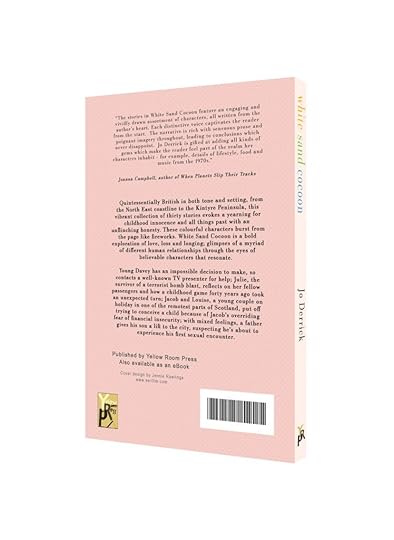
Is there an overarching theme?
I guess the overarching themes are of love, loss, longing and a yearning for childhood innocence. I experienced three bereavements in the space of fifteen years – first my father, then my first husband, then my mother. I think these experiences shape the person you become and are bound to colour one’s writing. I miss these people desperately and I do sometimes feel adrift. I think this comes across in the stories in this collection.
Who do you think it will appeal to?
I suppose the collection will appeal to fellow writers, first and foremost. I think fans of William Trevor, Elizabeth Bowen, Maggie O’Farrell and Helen Dunmore, for example, will enjoy the stories. They are more literary than commercial. I think the stories will appeal more to women than men, but having said that a lot of male friends purchased the collection as soon as it went on sale. The stories aren’t for the fainthearted. There’s a lot of sex, but the references are often quite subtle – sometimes not so subtle!
What makes a good flash?
An interesting question! For me, a good flash plunges the reader straight into a situation and setting.The story must come from character and it has to be a complete story, not just an anecdote. Obviously the essential thing about flash is not to waste words. No need to describe the colour of the walls unless it’s crucial to the story…. A good flash fiction writer will know how to edit and cut out unnecessary adjectives, adverbs and anything else that is superfluous. It’s all about fine tuning.
Who do you admire most among your contemporaries?
The first names that spring to mind are Joanna Campbell, Alison Wassell, Amanda Huggins, Melanie Whipman and Jonathan Pinnock [eek – JP]! Actually, there are a lot of short story writers I admire, including the regular womag fiction writers. Their output is breathtaking. I also admire anyone who can write a novel.
How easy was it to find a publisher? Did you consider self-publishing?
This collection is self-published. I’ve never even tried to find a publisher for my short story collection, but have tried to find one for my novel. I’ve also sent my novel out to several agents without success, although I’ve had some great, positive feedback. I think I should keep trying, having ‘only’ sent it to half a dozen so far.
Which other question would you have liked me to ask and what would be your answer to it?
Possibly ‘What is your favourite working method?’ And my answer would be ‘writing in notebooks’. I love nothing more than sitting on a bench in a pretty location observing what’s going on around me and noting it down. I don’t do this often enough. I also write down images, metaphors, character sketches, the way the light catches a certain object etc. Some of my best stories have started life from a set of images in a notebook. I find a train journey lends itself to writing something new and one of the best ways of getting ideas.
What’s next for you?
I have already started to put a second short story collection together and hope to publish it in the new year. Chapeltown Books had planned to publish my first Flash fiction collection before May this year, but didn’t fulfil the terms of the contract, so I’ve taken it back and will publish that under The Yellow Room Press around February time. I will continue to send my novel out to agents and will just keep writing whatever feels good in the moment.
Many thanks, Jo, and good luck!
The post Interview with Jo Derrick appeared first on Jonathan Pinnock - Writer of Stuff.
November 13, 2018
This is (Not About) David Bowie by F J Morris
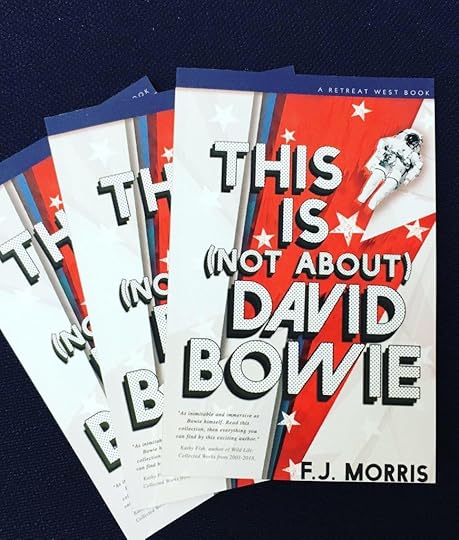
This is not a review about David Bowie. Rather, it’s a review of F J Morris’s new book “This is (Not About) David Bowie” from Retreat West Books. Or is it? Let’s see where this goes.
Writing about David Bowie is always a tricky thing to do because you first need to decide which David Bowie you’re going to talk about. When RCA were marketing David Bowie’s album “Heroes”, they came up with this slogan:
There’s Old Wave. There’s New Wave. And there’s David Bowie.
Now that was a fine statement, although it wasn’t strictly true, because he was always part of some wave or other – even if it was usually right at the crest. Neither was it true that he was (to use another popular description) the “chameleon of rock”, because he never blended into the background. Bowie’s genius lay in spotting a movement or style, adopting it as his own and transcending it. He was the Round Table (“adopt, adapt, improve”) of rock.
For example, the sonic world of the album “Aladdin Sane” belongs to a large extent to the pianist Mike Garson, and the sonic world of the “Heroes” single owes so much to the guitarist Robert Fripp, but in both cases the music unquestionably belongs to Bowie. Even “The Laughing Gnome” (yep, I’m going to go there) is the best Anthony Newley song that Anthony Newley never wrote (I’m not necessarily saying this is a good thing – it’s just an observation).
All of which makes Bowie the perfect vehicle for fandom: here is someone who can decide to be anyone they want and succeed at it, however outlandish that ambition may seem. How many uncertain creative people did he inspire to get out there and try?
It also makes his work the perfect canvas for any artist looking for somewhere to start from. Someone, perhaps, like Freya Morris, whose book was published this week. I was about to call it a “collection” but then I realised I wasn’t sure what it was a collection of. Sure, there’s flash fiction in there, but there’s also poetry and tiny dramas. Sometimes the inspiration is just a title and sometimes it’s more than that. Sometimes it’s hardly got anything to do with Bowie at all. However, like Bowie’s work, it all bears the stamp of its author.
Whatever the book is, and whether it really is about David Bowie or not, it makes for a fascinating read. It’s also a terrific tribute to him. He was a voracious reader, and I like to think he would have made time to read it. I think he would have appreciated it.
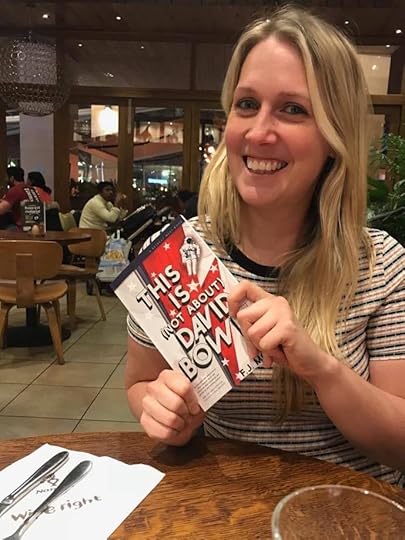
The post This is (Not About) David Bowie by F J Morris appeared first on Jonathan Pinnock - Writer of Stuff.



